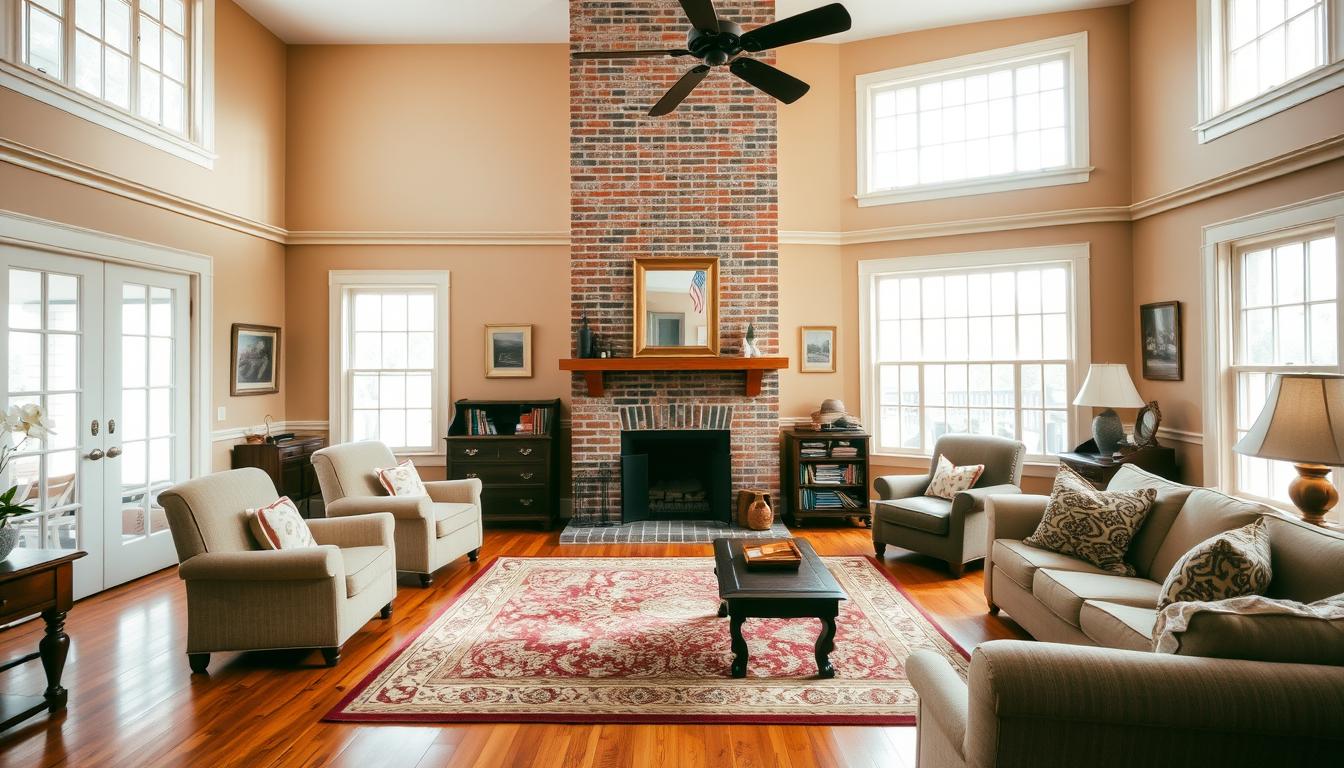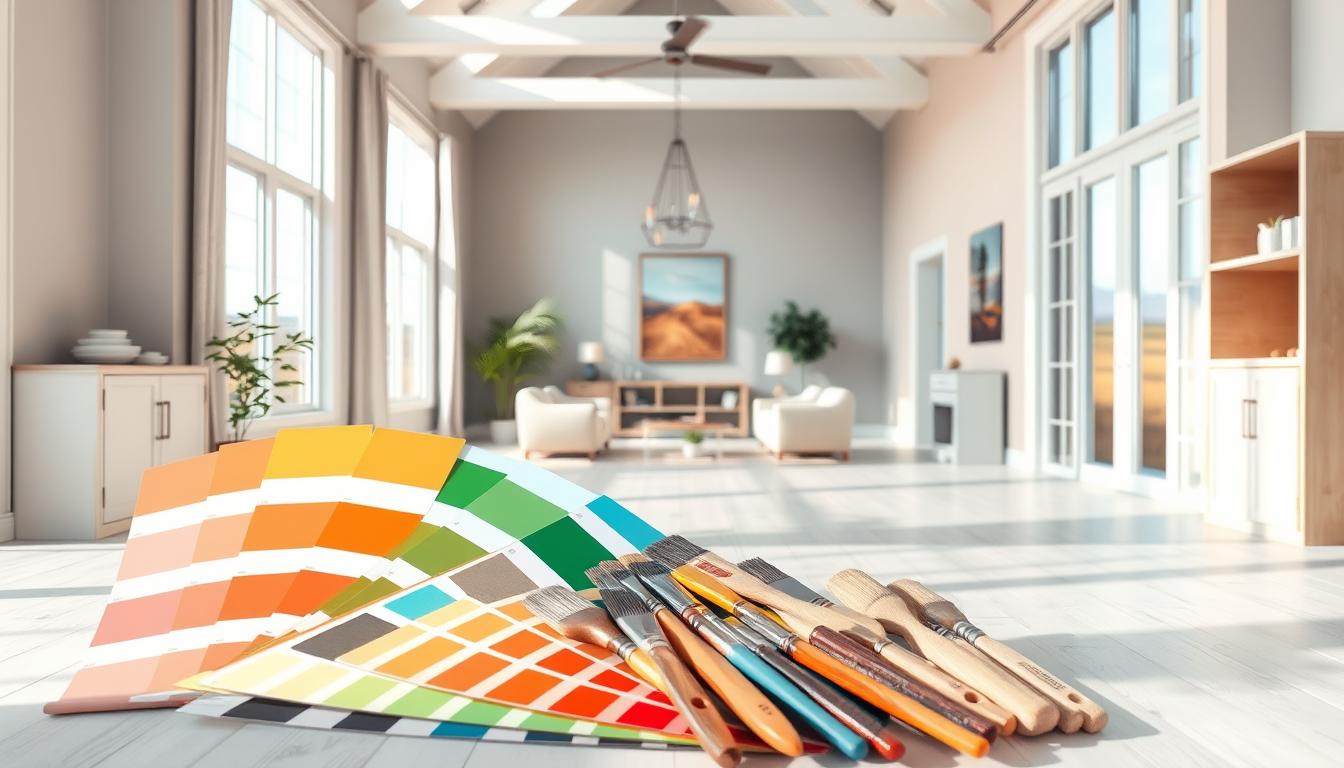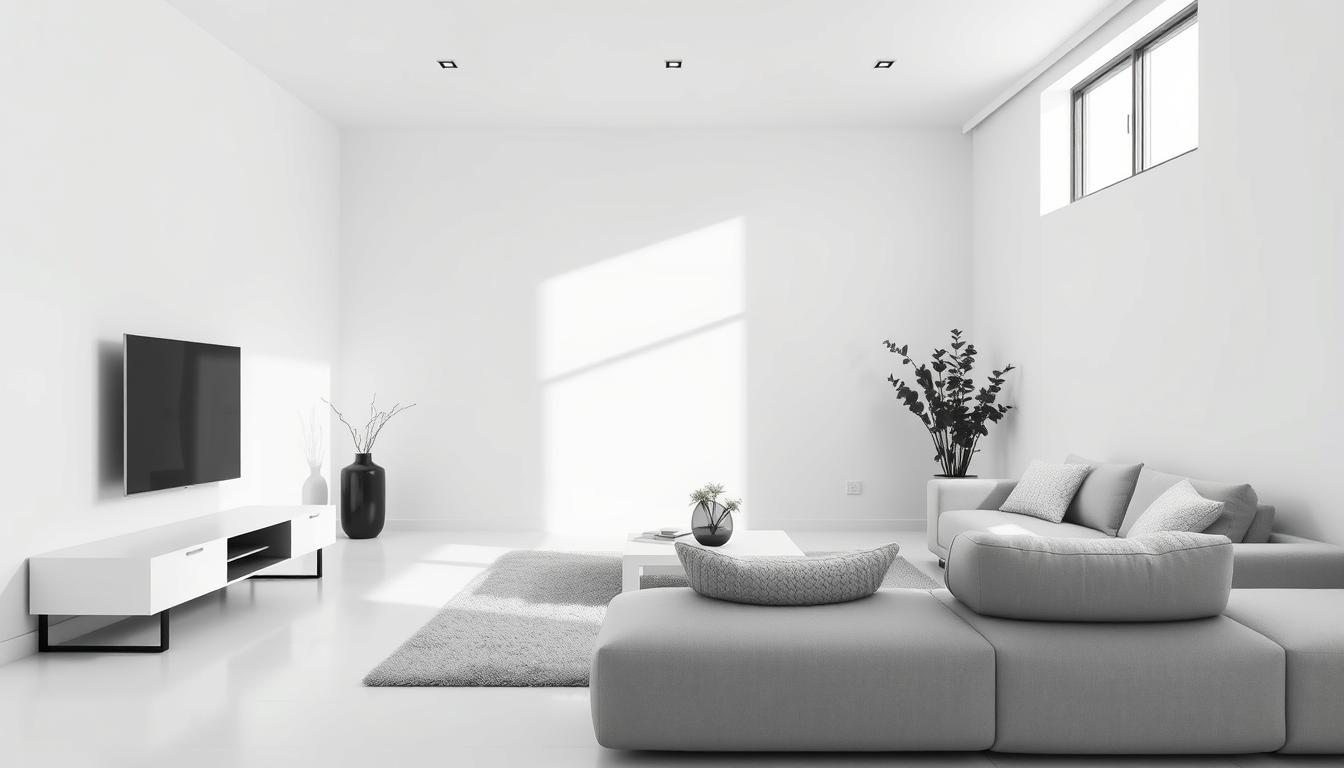Did you know colonial-style homes are super popular in the U.S.? They’re known for their classic beauty and rich history. These timeless homes make any space feel cozy and welcoming. Let’s dive into colonial home interior design and learn how to add this charm to your historic home.
With the right interior design touches, you can make your home both old and new. We aim to give you tips on mixing these elements in your historic home décor. This way, your home will truly show off your style.
Key Takeaways
- Understand the key characteristics of colonial interior design
- Learn how to incorporate traditional elements into your modern space
- Discover the importance of color palette and furniture choices
- Explore ways to add historic charm to your home’s décor
- Create a warm and inviting atmosphere that honors the past
Understanding Colonial Home Interior Design
To bring colonial charm into your home, you need to know the basics of colonial architecture and design. Colonial home interiors are simple, symmetrical, and classic. They reflect the style of the colonial era.
What Defines Colonial Architecture?
Colonial architecture shows the culture and history of its time. It has a simple, unadorned front, balanced shapes, and a central door. The door is often flanked by windows that are evenly spaced.
Key Features of Colonial Architecture:
- Symmetrical façade
- Classic proportions
- Simple, rectangular shape
- Central front door
- Evenly spaced windows
Key Characteristics of Colonial Interior Design
Colonial interior design aims to create a warm, inviting space. It uses rich colors, traditional furniture, and historic decor for a timeless look.
Some key traits include:
| Characteristic | Description |
|---|---|
| Rich Color Palette | Warm, earthy tones and deep colors that evoke a sense of history and tradition. |
| Traditional Furniture | Classic pieces such as four-poster beds, wingback chairs, and intricately carved wooden furniture. |
| Historic Decorative Elements | Elements like antique fixtures, vintage textiles, and classic patterns that add depth and character. |
“The essence of colonial interior design lies in its ability to balance tradition with a sense of warmth and comfort, creating a truly inviting home.”
By grasping these elements, you can bring traditional colonial design into your home. This will create a vintage home interior that’s both elegant and welcoming.
Color Palettes Inspired by Colonial Style
To bring the charm of colonial style into your home, it’s key to know the color palettes from that time. Colonial homes are known for their classic look, thanks to the right color choices.
Neutral Tones for a Classic Look
Beige, cream, and taupe are key in colonial interior design. These colors create a calm background for your decor. They let you add color through furniture and accessories.
Neutral tones don’t have to be dull. Mixing different shades and textures adds depth. For example, creamy whites with warm beiges make a space inviting. This makes your home feel elegant and welcoming.
Bold Accents to Highlight Spaces
Neutral tones are the base, but bold accents add character. Colors like red, blue, and yellow were used to bring life to interiors.
Bold accents can be furniture, rugs, or accessories. A colorful rug can mark a seating area. Bold throw pillows can brighten your sofa. This color strategy makes your space look good and functional.
By mixing neutral tones with bold accents, you get a balanced look. It honors the colonial era but also feels modern.
Choosing Furniture for Colonial Homes
Furnishing a colonial-style home is all about mixing old and new. It’s like blending colonial era interiors with today’s comforts. The goal is to keep the home’s historical charm while making it cozy and practical for now.
For those redoing a period home renovation, picking the right furniture is key. Traditional items like wooden chairs and tables are key to colonial design. They show off the era’s craftsmanship and add warmth to your space.
Traditional Furniture Pieces to Consider
When picking traditional furniture, aim for pieces true to the colonial era. Look for:
- Wooden furniture with detailed carvings
- Antique items that have been fixed up
- Furniture made from woods like oak, maple, and pine
These classic pieces are the heart of your design. They bring history and authenticity to your home.
Incorporating Modern Influences
While keeping traditional furniture is important, adding modern touches makes your home more functional and comfy. Think about:
- Modern fabrics on old frames
- Contemporary lights that match colonial furniture
- Simple decor that doesn’t clash with the old pieces
Mixing the old with the new creates a space that’s both unique and welcoming. It respects your home’s colonial roots while meeting today’s needs.
Flooring Options that Complement Colonial Decor
Flooring is key in a colonial-style home, with choices from classic hardwood to cozy area rugs. The right flooring can make your home feel warm and welcoming. Let’s look at the best flooring options for your vintage home.
Hardwood Flooring: Timeless Elegance
Hardwood flooring is a top pick for colonial homes, bringing timeless elegance. Its natural beauty, with different grain patterns and warm colors, fits well with colonial style. Oak, maple, and cherry are favorites, each adding its own charm.
Area Rugs for Warmth and Comfort
Area rugs add warmth and comfort to colonial homes. Rugs with traditional patterns, like florals or geometric shapes, enhance the vintage look. They also let you add more colors and textures, making the space richer.
When picking area rugs, think about size, material, and pattern. They should match your home’s style and era. This way, they’ll boost the colonial design of your home.
Colonial Lighting Fixtures: Setting the Mood
In colonial home design, lighting does more than just light up a room. It creates a mood that feels both historic and elegant. The right lighting can make a colonial-style home feel warm and welcoming.
“Lighting can change a space, and in colonial homes, it’s true,” say interior design experts. Chandeliers and wall sconces have been used for centuries to add elegance and sophistication.
Chandeliers that Evoke History
Chandeliers are key in colonial home design, often the centerpiece in grand rooms. To bring out the historical feel, look for chandeliers with classic designs. Think crystal drops or metalwork with detailed patterns.
A crystal chandelier adds glamour and sophistication, reflecting light beautifully. For a rustic or traditional vibe, metal chandeliers with a distressed look can warm up a room.
Wall Sconces for Ambiance
Wall sconces greatly impact the feel of a colonial-style home. They offer soft, warm light that can highlight architectural details or create cozy reading spots.
For a true colonial look, pick wall sconces that echo the era. Think candle-inspired lights or ornate metalwork. Layering lighting with overhead lights and wall sconces creates a rich, inviting atmosphere.
By choosing and placing lighting fixtures like chandeliers and wall sconces wisely, homeowners can achieve a classic design that’s both elegant and welcoming. This perfectly captures the essence of colonial home interior design.
Window Treatments in Colonial Interiors
Window treatments in colonial homes add a lot to their charm. They are not just for looks; they keep the home’s historical feel and look good too.
Choosing the right window treatments is key. Colonial homes often have heavy drapery and valances. These not only look good but also keep the home warm and control the light.
Drapery Styles that Fit the Era
Drapery in colonial homes is all about luxury. You’ll see curtains made of velvet and silk, often with fancy patterns and tassels. These drapes add elegance and keep the home’s history alive.
Some top drapery styles for colonial homes include:
- Heavy velvet curtains with gold tassels
- Silk drapes with intricate embroidery
- Layered valances with lace trim
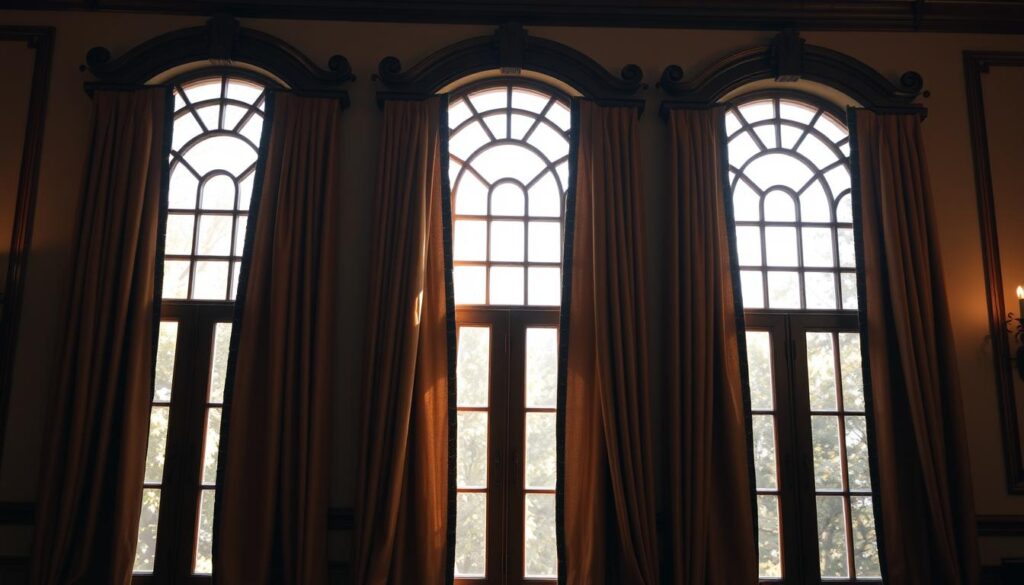
Shades and Blinds for Practicality
While drapes are important for looks, shades and blinds are key for everyday use. They help control light and keep things private without losing the home’s historical charm. Wooden blinds and roller shades are favorites for their simplicity and usefulness.
| Type | Description | Benefits |
|---|---|---|
| Wooden Blinds | Made from natural wood, these blinds add warmth to the room. | Durable, easy to clean, and provides excellent light control. |
| Roller Shades | Simple and sleek, roller shades are a practical choice. | Easy to operate, versatile, and available in various fabrics. |
| Roman Shades | These shades fold up when lifted, adding a touch of elegance. | Customizable, provides excellent light control, and adds texture. |
As interior design experts say, finding the right balance is key. The right drapes and shades or blinds can make a colonial home both charming and practical.
“The right window treatments can transform a room, adding both character and functionality. In colonial interiors, it’s all about balancing historical elements with modern needs.”
By picking window treatments that match the colonial era but also meet today’s needs, homeowners can mix tradition and modern style beautifully.
Incorporating Textiles in Colonial Design
Textiles in colonial design are more than just useful. They hold deep historical significance. In colonial America, textiles were a way to express oneself, find comfort, and even trade. Today, they add warmth, texture, and interest to our homes.
Fabrics with Historical Patterns
Some fabrics are more fitting for colonial design than others. Toile, damask, and brocade were favorites back then. These fabrics have historical patterns that can make your home feel more elegant.
Toile, with its classic scenes, can make your living room or bedroom elegant. You can use these fabrics for upholstery, drapery, or pillows. This way, you can create a look that truly captures the colonial spirit.
Layering Textures for Visual Interest
Layering textures is crucial in colonial design. Mixing velvet, linen, and wool adds depth and interest. For example, a velvet sofa with linen drapes and a wool rug makes a room inviting.
It’s important to balance textures to avoid overwhelming the space. Start with a main texture, like a plush rug. Then, add more textures with furniture, throw blankets, and pillows. This creates a harmonious, visually appealing space that feels warm and inviting.
By carefully choosing textiles with historical patterns and layering textures, you can bring colonial design into your home. This makes your space beautiful and rich in history.
Decorative Accents and Accessories
Decorative accents and accessories make a colonial-style home come alive. They add character and create a look that feels like the colonial era.
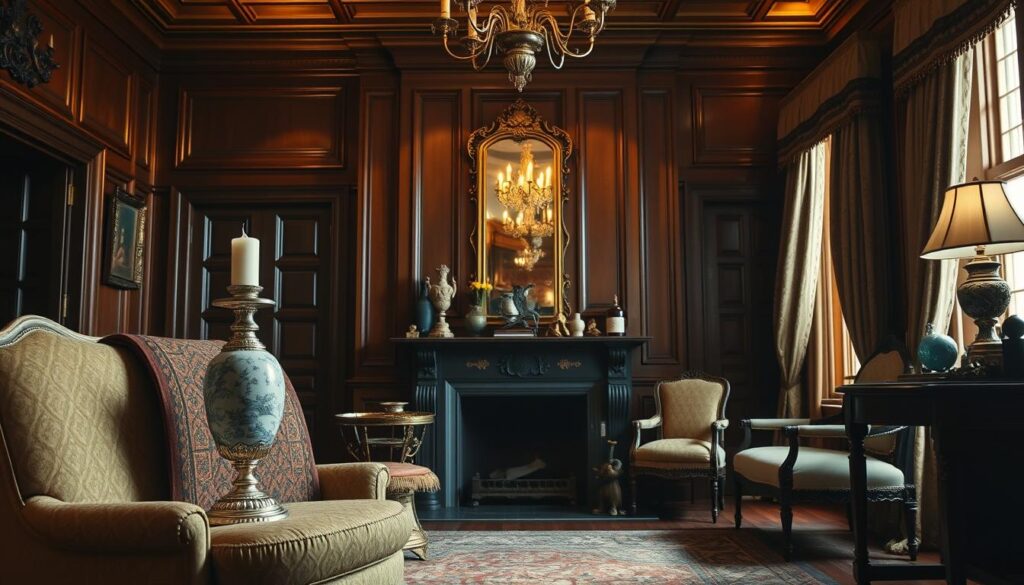
Authentic Pieces to Look For
Authenticity is crucial in traditional colonial design. Look for antique furniture that shows the era, such as:
- Antique clocks that add a touch of history
- Vintage textiles like quilts and tapestries
- Old metalware, including candlesticks and lanterns
You can find these items at antique shops, estate sales, or online. Make sure they’re in good shape or can be fixed.
DIY Ideas to Personalize Your Space
DIY projects can make your colonial-style home truly yours. Think about:
- Creating custom drapery with historical patterns
- Making hand-painted ceramics inspired by colonial designs
- Upcycling old furniture with a fresh coat of paint or new hardware
DIY projects let you add your personal touch while keeping the colonial charm.
By mixing authentic decorative accents with DIY touches, you can create a colonial-style home. It will be both historically rich and uniquely yours.
Landscaping and Exterior Considerations
When we move from inside to outside our colonial-style home, landscaping is key. The outside of a colonial home is vital to its charm. Good landscaping makes the home welcoming and true to its historical roots.
Complementing Interior Design with Curb Appeal
The outside landscaping should match the inside of your colonial home. Choose plants, hardscaping, and outdoor features that share the classic look of your interior. For example, if your home has traditional flooring and classic furniture, add a formal garden or a brick pathway outside.
A well-designed exterior boosts the home’s curb appeal and invites visitors in. Think about adding outdoor lighting that shows off the home’s features and adds warmth at night.
Historical Garden Designs for Colonial Homes
Colonial homes often have gardens that match their historical era. These gardens can be simple and symmetrical or more elaborate. Choose a garden design that fits your home’s history and style.
| Garden Design | Description | Historical Era |
|---|---|---|
| Symmetrical Garden | A formal garden with symmetrical plantings and pathways. | 18th Century |
| Cottage Garden | A charming, informal garden featuring a mix of flowers, herbs, and shrubs. | 17th Century |
| Ornate Garden | A elaborate garden featuring intricate patterns, topiaries, and ornate fountains. | 19th Century |
By using historical garden designs and careful landscaping, you can make your colonial home’s exterior beautiful. This will create a welcoming space that matches its classic interior.
Bringing Modern Touches to a Colonial Aesthetic
Mixing traditional colonial style with modern elements can make a living space unique and useful. Adding contemporary design to classic homes keeps their charm while making them more modern.
Striking a Balance
To mix old and new, pair colonial furniture with modern materials and designs. This mix creates a space that feels both historic and contemporary.
Innovative Design Solutions
Modernizing colonial interiors can include new lighting, smart tech, and updated fabrics. These additions respect the colonial look while making the space more functional.
By carefully combining old and new, we can make a colonial home that’s both stunning and practical. It meets today’s needs while keeping its historical charm.

